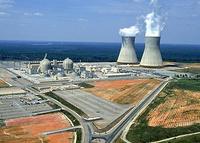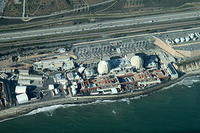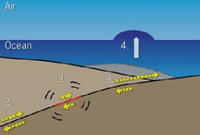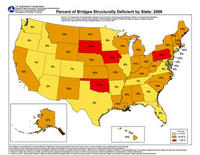-
U California, Berkeley students win National Student Steel Bridge Competition

The weekend of 31 May residents of Washington State watched as engineers began erecting a temporary steel bridge over the Skagit River, to replace the 160-foot span of a 4-lane bridge that had collapsed a week earlier, after being struck by an over-height truck. Just sixty miles away, on the campus of the University of Washington in Seattle, 620 civil engineering students erected their own temporary steel bridges in a competition to demonstrate their engineering skills. For the second consecutive year and for the second time in the past seven years, a team of students from the University of California, Berkeley captured the title as champions of the ASCE/AISC National Student Steel Bridge Competition (NSSBC).
-
-
Engineers on a wind load reconnaissance visit to tornado-hit Moore, Oklahoma
Eight days after an EF5 tornado struck Moore, Oklahoma, an 8-member team from the American Society of Civil Engineers’ (ASCE) Structural Engineering Institute (SEI) visited the area to assess the performance of critical facilities that either resisted or suffered significant damage from the estimated 200+ mph winds. The team studied four elementary schools and a hospital, and also examined the failures of long-span roof structures.
-
-
Increased U.S. crude oil production leads to dramatic fall in oil imports
The U.S. Energy Information Administration (EIA) issued its Annual Energy Outlook 2013 (AEO2013), which shows that under the assumption of crude oil production of about ten million bbl/d between 2020 and 2040 – which means total U.S. liquid fuels production (which includes crude oil, natural gas liquids (NGL), refinery gains, biofuels, and other liquid fuels) of more than eighteen million bbl/d in 2040 – net import of oil drops to 7 percent or less of total demand compared to 40 percent in 2012.
-
-
Israel taps 10th graders’ cybersecurity skills to expand cybersecuity recruitment pool
Israel has been subjected to a growing number of cyberattacks – and has itself used cyber-warfare against its adversaries. To make sure it stays ahead, Israel is accelerating its recruitment and development efforts in cybersecurity. Among other initiatives, the country is expanding the pool of potential cyberwarriors by going into high school classrooms to tap the cyber skills of tenth-graders.
-
-
Georgia’s Plant Vogtle may determine future of nuclear energy

Analysts say that the future of the U.S. nuclear industry, and of nuclear power generation in the United States, will largely depend on the success of two reactors, called Vogtle 3 and 4, at the Alvin Vogtle nuclear power plant in Georgia. For the nuclear industry, the Plant Vogtle project and another project in South Carolina may be the last hope of what many analysts consider to be a dying energy source.
-
-
Environmental group sues State Department for Keystone XL-related files
The Sierra Club has announced it is suing the State Department for files related to an environmental review draft of the Keystone XL pipeline. The group tried to gain access to the files through the Freedom of Information Act, but the request was denied, so the group filed the suit on Monday in the U.S. District Court in the Northern District of California.
-
-
Understanding next-generation nuclear fuel
The long search for the location of a rare element within nuclear fuel particles has ended. Researchers have finally pinpointed where silver congregates inside irradiated particles of a new type of nuclear fuel. The finding will help scientists better understand how select fission products such as silver can escape from tristructural isotropic (TRISO) fuel. This specialized fuel could run high-temperature gas-cooled reactors (HTGRs) that have numerous enhanced safety features.
-
-
House panel to unveil cybersecurity bill
Republicans on the House Homeland Security Committee are close to finalizing a long-awaited cybersecurity bill, following extensive discussions with private companies.The bill formally establishes DHS’s already-operating National Cybersecurity and Communications Integration Center, to circulate cyberthreat and vulnerability data.
-
-
Making jet fuel from switchgrass

The Energy Department’s National Renewable Energy Laboratory (NREL) is partnering with Cobalt Technologies, U.S. Navy, and Show Me Energy Cooperative to demonstrate that jet fuel can be made economically and in large quantities from a renewable biomass feedstock such as switch grass. The project could spur jobs in rural America, lead to less reliance of foreign oil.
-
-
California’s San Onofre nuclear power plant retired due to safety concerns

Southern California Edison (SCE) has decided it will retire the San Onofre nuclear power plant located on the California coast. The decision comes after officials debated for over a year whether the twin reactors could be safely restarted. The power plant is located in a populated area, with millions living near it.
-
-
Earthquake acoustics can indicate a massive tsunami is coming

Although various systems can detect undersea earthquakes, they cannot reliably tell which will form a tsunami, or predict the size of the wave. There are ocean-based devices that can sense an oncoming tsunami, but they typically provide only a few minutes of advance warning. Scientists have now identified key acoustic characteristics of the 2011 Japan earthquake that indicated it would cause a large tsunami. The technique could be applied worldwide to create an early warning system for massive tsunamis.
-
-
Thousands of U.S. bridges in “fracture critical” condition

There are currently 66,749 structurally deficient bridges and 84,748 functionally obsolete bridges in the United States – about a quarter of the nation’s 607,000 bridges. With declining federal funds for bridge repair, the burden of maintenance has shifted to states, which spent $28.5 billion last year on bridge work – up from $12.3 billion in 1998.
-
-
Protecting and climate proofing Europe’s coast
The coastline of EU member states extends over 17,000 kilometers. It is home to seventy million inhabitants. The estimated value of the assets within 500 meters from the coast rises to a staggering 1,000 billion Euros. An EU-funded science and engineering initiative is gathering all relevant scientific knowledge to develop a systematic approach to deliver a safe, natural, and climate-proof European coast.
-
-
Smarter energy use by industry could cut U.K. electricity demand by 75 percent
As the U.K. government debates the U.K. Energy Bill, new research has found that turning down non-essential services, such as heating, air-conditioning, and pumping equipment, at times of peak electricity demand could play a far greater role in helping the United Kingdom achieve future energy security.
-
-
U.S. hurricane supercomputers need an upgrade
During the hurricane season, which began last week, the U.S. National Weather Service (NWS) will use models from several supercomputers from around the world to generate predictions about hurricanes’ landfall, path, and intensity. Meteorologists say that the two American supercomputers used for storm modeling are underpowered and inferior to European computers.
-
More headlines
The long view
Water Wars: A Historic Agreement Between Mexico and US Is Ramping Up Border Tension
As climate change drives rising temperatures and changes in rainfall, Mexico and the US are in the middle of a conflict over water, putting an additional strain on their relationship. Partly due to constant droughts, Mexico has struggled to maintain its water deliveries for much of the last 25 years, deliveries to which it is obligated by a 1944 water-sharing agreement between the two countries.
Trump Is Fast-Tracking New Coal Mines — Even When They Don’t Make Economic Sense
In Appalachian Tennessee, mines shut down and couldn’t pay their debts. Now a new one is opening under the guise of an “energy emergency.”
Smaller Nuclear Reactors Spark Renewed Interest in a Once-Shunned Energy Source
In the past two years, half the states have taken action to promote nuclear power, from creating nuclear task forces to integrating nuclear into long-term energy plans.
Keeping the Lights on with Nuclear Waste: Radiochemistry Transforms Nuclear Waste into Strategic Materials
How UNLV radiochemistry is pioneering the future of energy in the Southwest by salvaging strategic materials from nuclear dumps –and making it safe.
Model Predicts Long-Term Effects of Nuclear Waste on Underground Disposal Systems
The simulations matched results from an underground lab experiment in Switzerland, suggesting modeling could be used to validate the safety of nuclear disposal sites.
